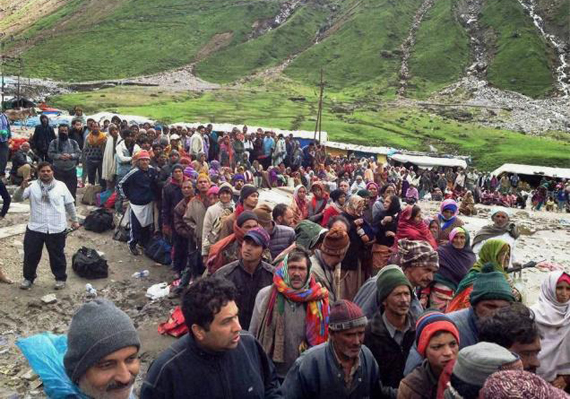
Home Minister Sushilkumar Shinde said so far 22 helicopters have been used to evacuate stranded people to safer locations and through hundreds of sorties they rescued 22,392 people.
“But 22 helicopters are not enough. So, we have requested the Defence Ministry to deploy more helicopters to expedite the rescue operations in Uttarakhand. The Defence Ministry agreed to our request and hopefully the additional choppers will be deployed soon,” he told reporters in New Delhi.
According to the Home Ministry, as many as 62,122 people are still stranded in different inaccessible locations in the flood-ravaged Uttarakhand.
Asked whether the death toll in Uttarakhand could go up, the Home Minister said he has spoken to Uttarakhand Chief Minister Vijay Bahuguna who conveyed that it was difficult to tell the exact number of people who died since all debris have not been cleared yet.
“It may go up. But we cannot say now,” he said.
Mr. Shinde said due to bad weather on Thursday morning, rescue operation has been hit in Uttarakhand.
He said he has convened a high-level meeting on Friday to take stock of the relief and rescue operations.
Representatives of Ministries of Home, Defence, Food, the National Disaster Management Authority and other stake holders will attend the meeting.
According to the latest situational report sent to the Home Ministry summarising progress of rescue and relief operations, 13 teams of the National Disaster Response Force (NDRF) consisting of 422 personnel and 3,000 personnel of ITBP, besides hundreds of Army personnel are engaged in rescue works in Uttarakhand.
Daily meetings under the chairmanship of Home Secretary R.K. Singh are being held on to review the situation and the relief and rescue measures being undertaken in Uttarakhand and Himachal Pradesh, an official statement said.
Senior officers of the Ministry of Home Affairs are in constant touch with senior officers concerned of Uttarakhand for extending the required support and assistance.
As per Indian Meteorological Department (IMD), cumulative rainfall of Uttarakhand is reported 385.1 mm actual against normal rainfall of 71.3 mm, which is 440 per cent excess during the southwest monsoon period of June 1 to June 18.
One team of NDRF and one team of ITBP have been placed at Kedarnath and Gaurigaon to assist in the evacuation both from Kedarnath and Gaurigaon. Evacuation operations were carried out yesterday using helicopters till the weather deteriorated.
One team of ITBP operated between Govindghat and Joshimath and evacuated pilgrims stuck there, the statement said.
It was also decided that ITBP would launch teams from Pithoragarh to all the valleys in the district to see if the villagers or stranded persons require any assistance.
As per the reports received from Himachal Pradesh government, due to continuous rainfall in the region during June, severe damage to life and property was caused in several locations in different parts of the state.
The search, rescue and relief operations are being carried out with the help of helicopters from Army, Air Force, NDRF, ITBP and State government and there was no shortage of food material.
Supreme Court directs Centre, Uttarakhand to rescue people
The Supreme Court on Thursday directed the Centre and Uttarakhand governments to make all out efforts to rescue thousands of people stranded in the State due to flash floods and provide them food and drinking water.
A bench of justices A.K. Patnaik and Ranjan Gogoi directed the governemnts to deploy sufficient number of helicopters to rescue flood-affected people in the area.
“We direct as an interim measure that all stranded people be provided immediate relief by the state and district authorities by giving them food, medicines and other essential things including fuel,” the bench said.
It asked the Centre and National Disaster Management Authority to provide all required resources to the State governemnt.
The court passed the order on a PIL filed by a lawyer Ajay Bansal seeking its direction to Centre and State governemnt to rescue people stranded in the State.
The bench also said that authorities should not discriminate among the affected people in relief and rehabilitation operations after the petitioner alleged that government agencies are neglecting people stranded in Gangotri.
It also asked the Centre to file a report on the relief and rehabilitation work in the State on June 25 when the case will be taken up for further hearing.
“We also direct, depending on the availability of helicopters, sufficient number of helicopters be deployed for picking up the stranded persons,” the apex court said in its order.
Although the official toll is over 150, it is feared that thousands of pilgrims staying in 90 rest houses may have been washed away.





Comments
Add new comment